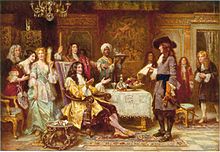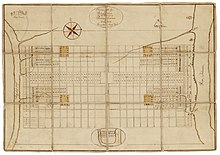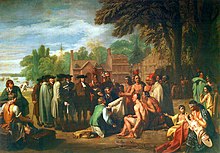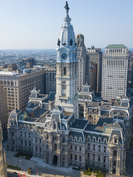
A | B | C | D | E | F | G | H | CH | I | J | K | L | M | N | O | P | Q | R | S | T | U | V | W | X | Y | Z | 0 | 1 | 2 | 3 | 4 | 5 | 6 | 7 | 8 | 9
Philadelphia | |
|---|---|
|
| |
| Etymology: Ancient Greek: φίλος phílos (beloved, dear) and ἀδελφός adelphós (brother, brotherly) ———-——— | |
| Nickname(s): "Philly", "The City of Brotherly Love", others | |
| Motto: | |
 Interactive map outlining Philadelphia | |
Location within the state of Pennsylvania Location within the United States Location in North America Location on Earth | |
| Coordinates: 39°57′10″N 75°09′49″W / 39.9528°N 75.1636°W | |
| Country | United States |
| State | Pennsylvania |
| County | Philadelphia |
| Historic countries | Kingdom of England Kingdom of Great Britain |
| Historic colony | Province of Pennsylvania |
| Founded | 1682[3] |
| Incorporated | October 25, 1701 |
| Founded by | William Penn |
| Government | |
| • Type | Mayor–council, consolidated city-county |
| • Body | Philadelphia City Council |
| • Mayor | Cherelle Parker (D) |
| Area | |
| • Consolidated city-county | 142.70 sq mi (369.59 km2) |
| • Land | 134.36 sq mi (347.98 km2) |
| • Water | 8.34 sq mi (21.61 km2) |
| Elevation | 39 ft (12 m) |
| Population | |
| • Consolidated city-county | 1,603,797 |
| • Estimate (2022)[6] | 1,567,258 |
| • Rank | 10th in North America 6th in the United States 1st in Pennsylvania |
| • Density | 11,936.92/sq mi (4,608.86/km2) |
| • Urban | 5,696,125 (US: 7th) |
| • Urban density | 3,000.8/sq mi (1,158.6/km2) |
| • Metro | 6,245,051 (US: 7th) |
| Demonym | Philadelphian |
| GDP | |
| • Philadelphia (MSA) | $518.5 billion (2022) |
| Time zone | UTC−5 (EST) |
| • Summer (DST) | UTC−4 (EDT) |
| ZIP Codes | 19092–19093, 19099, 191xx |
| Area codes | 215, 267, 445 |
| FIPS code | 42-60000 |
| GNIS feature ID | 1215531[10] |
| Website | www.phila.gov |
Philadelphia, commonly referred to as Philly, is the most populous city in the U.S. state of Pennsylvania[11] and the sixth-most populous city in the nation, with a population of 1,603,797 in the 2020 census. The city is the urban core of the larger Delaware Valley, also known as the Philadelphia metropolitan area, the nation's seventh-largest and one of the world's largest metropolitan regions with 6.245 million residents in its metropolitan statistical area and 7.366 million residents in its combined statistical area.[12]
Philadelphia is known for its extensive contributions to United States history. The city served as the nation's capital until 1800.[13] It maintains contemporary influence in business and industry, culture, sports, and music.[14][15] Philadelphia was founded in 1682 by William Penn, an English Quaker and advocate of religious freedom. The city served as the capital of the Pennsylvania Colony during the British colonial era[3][16] and went on to play a historic and vital role as the central meeting place for the nation's founding fathers. Philadelphia hosted the First Continental Congress in 1774, preserved the Liberty Bell, and hosted the Second Continental Congress during which the founders signed the Declaration of Independence.[17] The U.S. Constitution was later ratified in Philadelphia at the Philadelphia Convention of 1787. Philadelphia remained the nation's largest city until 1790, served as the nation's first capital from May 10, 1775, until December 12, 1776, and on four subsequent occasions during and following the American Revolution, including from 1790 to 1800 during the construction of the new national capital of Washington, D.C.
With 18 four-year universities and colleges, Philadelphia is one of the nation's leading centers for higher education and academic research.[18][19] As of 2018[update], the Philadelphia metropolitan area was the state's largest and nation's ninth-largest metropolitan economy with a gross metropolitan product of US$444.1 billion. The city is home to five Fortune 500 corporate headquarters as of 2022.[20] As of 2023, metropolitan Philadelphia ranks among the top five U.S. venture capital centers, facilitated by its proximity to New York City's entrepreneurial and financial ecosystems.[21] The Philadelphia Stock Exchange, owned by Nasdaq since 2008, is the nation's oldest stock exchange and a global leader in options trading.[22] 30th Street Station, the city's primary rail station, is the third-busiest Amtrak hub in the nation, and the city's multimodal transport and logistics infrastructure also includes Philadelphia International Airport, a major Transatlantic hub,[23] and the rapidly-growing PhilaPort seaport.[24]
Philadelphia is a national cultural center, hosting more outdoor sculptures and murals than any other city in the nation.[25][26] Fairmount Park, when combined with adjacent Wissahickon Valley Park in the same watershed, is 2,052 acres (830 ha), representing one of the nation's largest and the world's 45th-largest urban park.[27] The city is known for its arts, culture, cuisine, and colonial and Revolution-era history; in 2016, it attracted 42 million domestic tourists who spent $6.8 billion, representing $11 billion in economic impact to the city and its surrounding Pennsylvania counties.[28] With five professional sports teams and one of the nation's most loyal fan bases, Philadelphia is often ranked as the nation's best city for professional sports fans.[29][30][31][32] The city has a culturally and philanthropically active LGBTQ+ community. Philadelphia also has played an immensely influential historic and ongoing role in the development and evolution of American music, especially R&B, soul, and rock.[33][34]
Philadelphia is a city of many firsts, including the nation's first library (1731),[35] hospital (1751),[35] medical school (1765),[36] national capital (1774),[37] university (by some accounts) (1779),[38] central bank (1781), stock exchange (1790),[35] zoo (1874),[39] and business school (1881).[40] Philadelphia contains 67 National Historic Landmarks, including Independence Hall.[41][42][19] From the city's 17th century founding through the present, Philadelphia has been the birthplace or home to an extensive number of prominent and influential Americans. In 2021, Time magazine named Philadelphia one of the world's greatest 100 places.[43] Two years later, in 2023, travel guide publisher Lonely Planet ranked Philadelphia the best city in the nation to visit.[44]
History
Native peoples
Prior to the arrival of Europeans in the early 17th century, the Philadelphia area was home to the Lenape (Delaware) Indians in the village of Shackamaxon. They were also called the Delaware Indians,[45] and their historical territory was along the Delaware River watershed, western Long Island, and the Lower Hudson Valley.[a] Most Lenape were pushed out of their Delaware homeland during the 18th century by expanding European colonies, exacerbated by losses from intertribal conflicts.[45] Lenape communities were weakened by newly introduced diseases, mainly smallpox, and conflict with Europeans. The Iroquois occasionally fought the Lenape. Surviving Lenape moved west into the upper Ohio River basin. The American Revolutionary War and the United States' independence pushed them further west. In the 1860s, the United States government sent most Lenape remaining in the eastern United States to the Indian Territory to present-day Oklahoma and surrounding territories under the Indian removal policy.
Colonial



Europeans came to the Delaware Valley in the early 17th century. The first settlements were founded by Dutch colonists, who built Fort Nassau on the Delaware River in 1623 in what is now Brooklawn, New Jersey. The Dutch considered the entire Delaware River valley to be part of their New Netherland colony. In 1638, Swedish settlers led by renegade Dutch established the colony of New Sweden at Fort Christina, located in present-day Wilmington, Delaware, and quickly spread out in the valley. In 1644, New Sweden supported the Susquehannocks in their war against Maryland colonists.[46] In 1648, the Dutch built Fort Beversreede on the west bank of the Delaware, south of the Schuylkill River near the present-day Eastwick section of Philadelphia, to reassert their dominion over the area. The Swedes responded by building Fort Nya Korsholm, or New Korsholm, named after a town in Finland with a Swedish majority.
In 1655, a Dutch military campaign led by New Netherland Director-General Peter Stuyvesant took control of the Swedish colony, ending its claim to independence. The Swedish and Finnish settlers continued to have their own militia, religion, and court, and to enjoy substantial autonomy under the Dutch. An English fleet captured the New Netherland colony in 1664, though the situation did not change substantially until 1682, when the area was included in William Penn's charter for Pennsylvania.[47]
In 1681, in partial repayment of a debt, Charles II of England granted Penn a charter for what would become the Pennsylvania colony. Despite the royal charter, Penn bought the land from the local Lenape in an effort to establish good terms with the Native Americans and ensure peace for the colony.[48] Penn made a treaty of friendship with Lenape chief Tammany under an elm tree at Shackamaxon, in what is now the city's Fishtown neighborhood.[3] Penn named the city Philadelphia, which is Greek for "brotherly love", derived from the Ancient Greek terms φίλος phílos (beloved, dear) and ἀδελφός adelphós (brother, brotherly). There were a number of cities named Philadelphia in the Eastern Mediterranean during the Greek and Roman periods, including modern Alaşehir, mentioned as the site of an early Christian congregation in the Book of Revelation. As a Quaker, Penn had experienced religious persecution and wanted his colony to be a place where anyone could worship freely. This tolerance, which exceeded that of other colonies, led to better relations with the local native tribes and fostered Philadelphia's rapid growth into America's most important city.[49]
Penn planned a city on the Delaware River to serve as a port and place for government. Hoping that Philadelphia would become more like an English rural town instead of a city, Penn laid out roads on a grid plan to keep houses and businesses spread far apart with areas for gardens and orchards.
The city's inhabitants did not follow Penn's plans, however, and instead crowded the present-day Port of Philadelphia on the Delaware River and subdivided and resold their lots.[50] Before Penn left Philadelphia for the final time, he issued the Charter of 1701 establishing it as a city. Though poor at first, Philadelphia became an important trading center with tolerable living conditions by the 1750s. Benjamin Franklin, a leading citizen, helped improve city services and founded new ones that were among the first in the nation, including a fire company, library, and hospital.
A number of philosophical societies were formed, which were centers of the city's intellectual life, including the Philadelphia Society for Promoting Agriculture (1785), the Pennsylvania Society for the Encouragement of Manufactures and the Useful Arts (1787), the Academy of Natural Sciences (1812), and the Franklin Institute (1824).[51] These societies developed and financed new industries that attracted skilled and knowledgeable immigrants from Europe.
American Revolution
Zdroj:https://en.wikipedia.org?pojem=Philadelphia,_PennsylvaniaText je dostupný za podmienok Creative Commons Attribution/Share-Alike License 3.0 Unported; prípadne za ďalších podmienok. Podrobnejšie informácie nájdete na stránke Podmienky použitia.
Antropológia
Aplikované vedy
Bibliometria
Dejiny vedy
Encyklopédie
Filozofia vedy
Forenzné vedy
Humanitné vedy
Knižničná veda
Kryogenika
Kryptológia
Kulturológia
Literárna veda
Medzidisciplinárne oblasti
Metódy kvantitatívnej analýzy
Metavedy
Metodika
Text je dostupný za podmienok Creative
Commons Attribution/Share-Alike License 3.0 Unported; prípadne za ďalších
podmienok.
Podrobnejšie informácie nájdete na stránke Podmienky
použitia.
www.astronomia.sk | www.biologia.sk | www.botanika.sk | www.dejiny.sk | www.economy.sk | www.elektrotechnika.sk | www.estetika.sk | www.farmakologia.sk | www.filozofia.sk | Fyzika | www.futurologia.sk | www.genetika.sk | www.chemia.sk | www.lingvistika.sk | www.politologia.sk | www.psychologia.sk | www.sexuologia.sk | www.sociologia.sk | www.veda.sk I www.zoologia.sk












